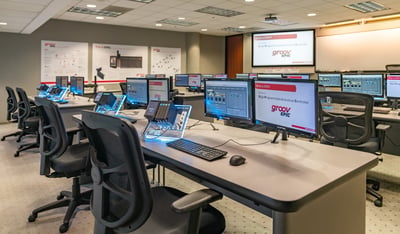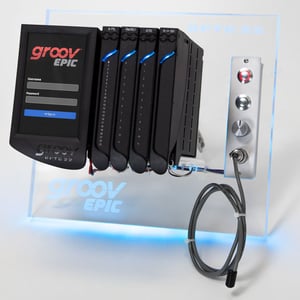Documenting the journey from the outside world into the world of Opto: First in a series.
After more than a decade as an automation engineer, I recently joined Opto 22’s marketing group. A few weeks ago, my workday was focused on maintaining the cell culture process automation of a world-class pharmaceutical manufacturer. This system had dozens of distributed controllers and hundreds of devices that worked together to deliver thousands of kilograms of the finest monoclonal antibodies you’ve ever seen. It was big.
What I enjoyed most about my job, though, was helping other engineers succeed. In the early years, I learned pretty quickly that you could take a group of smart people, give them bad tools, callous management, and a ridiculous schedule, and they would fail every time. I did the best I could to fix the managerial and scheduling issues, but the tools were always a limitation.
Now it’s my job to help connect other engineers with the kinds of tools and technologies I wish I’d had. I’m kicking it off with a deep-dive into the first place I visited as a new Opto employee: the training room.
If you’re wondering whether it’s worth your time and money to get some Opto training yourself, I’ll be walking through everything you can expect to experience.
Day 1 of 3 - Welcome to the edge
 I’ve been an employee of Opto 22 for 24 hours, and I’m sitting down for my first hands-on experience with the groov EPIC® system in one of the factory’s 3-day training sessions.
I’ve been an employee of Opto 22 for 24 hours, and I’m sitting down for my first hands-on experience with the groov EPIC® system in one of the factory’s 3-day training sessions.
First of all, this is one of the nicest training rooms I’ve been in. Apart from being more purpose-built than a simple conference room, it just feels like tech learning is about to happen.
There’s a dais, screen and control center at the far end where the lecturer, Norma Rodriguez, is currently piping in Vitamin String Quartet. Each workstation is equipped with dual monitors, a keyboard and mouse, and a groov EPIC Learning Center (LC), sporting a GRV-EPIC-PR1 and four I/O modules (DI, DO, temperature and AI). The controller is mounted in plexiglass and pre-wired with push buttons, LEDs, a temp sensor and potentiometer (the same way the LC arrives out of the box). There’s a blue glow emanating from each one, like they’re charging their anti-grav in preparation for lift-off.
We go through some intros while we polish off danishes and coffee. This session of class consists of seven other control systems, SCADA, and IIoT professionals. Everyone is here with a purpose. Back home they need to connect the factory floor to the back office, take a slew of legacy PLCs and integrate them into a system of managed data, or put a next-generation controller in place before their old stuff hits obsolescence. They all want to know what IoT technologies can do for them in the future.
 First topic: an overview of the system and how to get it talking. I’m pleasantly surprised at the simple, solid build of the assembled controller. No clips or clamps or sliding stuff around. Everything hooks onto a stainless steel backplane and tightens down with a single retaining screw. The power supply actually sits behind/below the processor to save panel space. If I have a complaint at this point, it’s with the spring-clamp I/O terminals—I know some people love them; I’m not one of them, but mostly because my customers haven’t been. (Let me know which side you are on in the comments below.)
First topic: an overview of the system and how to get it talking. I’m pleasantly surprised at the simple, solid build of the assembled controller. No clips or clamps or sliding stuff around. Everything hooks onto a stainless steel backplane and tightens down with a single retaining screw. The power supply actually sits behind/below the processor to save panel space. If I have a complaint at this point, it’s with the spring-clamp I/O terminals—I know some people love them; I’m not one of them, but mostly because my customers haven’t been. (Let me know which side you are on in the comments below.)
Getting the controller talking is a snap, though. groov Manage is layer 1 of the EPIC system and most of the configuration is done through the built-in color touchscreen. We walk through setting up the admin account (for security reasons, there’s no default), setting the hostname, and grabbing the IP. I struggled a little bit with the touchscreen at first, but once I figured out the right amount of pressure, it was comfortable.
From there we do the rest of our config through a web browser. We go through menus for every aspect of the EPIC: firewall settings, time servers, display settings, user management, SSH licensing, file security, I/O diagnostics, and so on—all in groov Manage and all through the browser. Neat.
The famous Ben Orchard preaches the word on networking and security best practices before we jump into PAC Control™.
I’m also a newbie to PAC Control. I’ve written quite a lot of ladder logic, FBD (function block diagram) and SFC (sequential function chart), and by comparison, this is pretty intuitive. We will spend the rest of the day building out a convenience store monitoring and control system, but first...
Lunch! This might be my favorite hour of the day. That makes it sound like the rest wasn’t great, but hear me out... Yes, we’re eating Mexican food, and before we weren’t; so that’s a big plus. More importantly, though, while we’re doing that, Terry Orchard gives us the lowdown on SSH access on groov EPIC. :-O
Coming from a computer science background, my mind is thoroughly blown by the end of this presentation. This is it! This is what I’ve wanted for more than ten years. How many times have I had to write external scripts to do things my controller or HMI should have been able to do? How many times have I wished I could write Python (or Java or C) to handle my control logic instead of the structure-less, scope-less ladder logic spaghetti I had to maintain? Use an IPC, you say? Sometimes that makes sense, but in many cases you can’t beat the reliability, cost, and I/O options of PLCs. If only they were as powerful, right?
Well, my keyboard is covered in drool, so I’m going to stop right there. Terry has written a great post on enabling SSH, and there is a sweet suite of tools documented at developer.opto22.com.
Back to PAC Control.
Actually, one thing I’ve left out up to this point is the amount of discussion that’s been going on all morning. A quick summary:
- Which SNAP I/O will be ported to the EPIC?
- What is the recommended configuration for redundant operation?
- What limitations are there in how I/O modules can be grouped?
- Which field network options does groov EPIC support?
- How do the groov Box™ and groov EPIC differ?
- How do OPC-UA and MQTT compare?
- Can we migrate old PAC Control strategies to groov EPIC?
The answers were too nuanced and extensive to include all of them in this post, but drop me a line in the comments if you’re interested. I’ll try to point you in the right direction.
OK, now back to PAC Control. Pretty quickly I’m building my first flowcharts (closer to Think & Do than SFC, if that helps any of the other PAC Control newbs), and not long after that we’re building OptoScript™ expressions. The example application we are walking through is straightforward, just a framework to give us some context for learning how to interact with I/O, move data around, and debug our application.
At this point we get schooled by Ben again. The topic is PID control and tuning, and, if we’re being honest, as an industry, we’re kind of a mixed bag when it comes to this subject. If you come from a background in engineering, your education probably included a lot of control theory. If you’re like me and a lot of other folks, PID control was something you picked up in the field. Today’s group seems to include both cases. Fortunately, Ben has done this a thousand times in real-life applications, and we have a couple collective, “Oooooh, that’s how it works…” moments before we jump into configuring an actual heating loop.
The day wraps up for me in an after-hours debug session with Norma and one other student. I missed setting up a couple parameters, so my TPO isn’t working properly. (Be nice! I was distracted by note-taking.) Norma gently points out my mistakes, and I end the day a little wiser.
Day 1 wrap-up
The first day of premium factory training was fun and eye-opening. Being new to Opto development tools, I was happy to see that adding PAC Control to my tool box wouldn’t be hard. And of course, seeing what Terry could do in the groov EPIC shell definitely fulfilled a wish for me.
Norma, Ben, and Terry will be featured again in day 2 of factory training, so stay tuned for more. We get into PAC Display™, groov View™, Ignition Edge®, and the CODESYS® environment.
Have you attended factory training before? Let me know how your experience was in the comments section. And don’t worry; if a trip to California is definitely not in your future, we continue to build out the (always free) content at Opto U.
See you next time!
